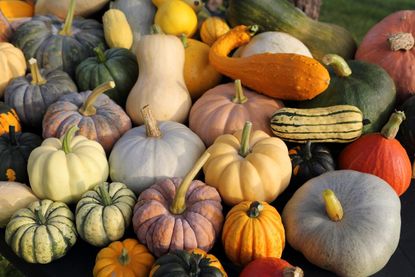Will Melons Cross With Squash: Growing Cucurbits Next To Each Other


There are many half-truths regarding gardening. One of the more common ones concerns planting cucurbits next to each other. The scuttlebutt is that planting cucurbits too close together will result in oddball squash and gourds. Since I’m calling this a half-truth, then obviously there is some fact and some fiction with regards to this particular piece of folklore. So what is the truth; will melons cross with squash, for instance?
Cucurbit Cross Pollination
The cucurbit family includes:
Since they reside in the same family, many folks believe that there will be cross pollination between the members. Although they all have similar flowering habits, bloom around the same time and, of course, are family members, it is not true that all cucurbits will cross pollinate. The female flower of each can only be fertilized by pollen from the male flowers of the same species. However, cross pollination can occur between varieties within a species. This is often seen in squash and pumpkins. Many people who have a compost area will be surprised (at first) to see squash plants that, if allowed to come to fruition, will be a combination of different squash. For this reason, summer squash, pumpkins, gourds, and various winter squashes that all fall into the same plant species of Cucurbita pepo may cross pollinate with one another. So, yes, you may end up with some oddball squash and gourds. How about melons and squash? Will melons cross with squash? No, because although they are within the same family, melons are a different species than squash.
Growing Cucurbits Close Together
What isn’t true is that this has nothing to do with planting cucurbits too close together. In fact, during the growing season and up to harvest, no noted change will be observed if cross pollination has taken place. It is in the second year, likely to happen if you want to save seeds for example, that any cross pollination will be evident. Only then would it be likely to get some interesting combos of squash. You can think of this as a good thing or a bad thing. Many amazing veggies are lucky accidents, and unintended cucurbit cross pollination might actually be fortuitous. The resulting fruit might be delicious, or at the very least an interesting experiment. What is sure, however, is that you can continue to plant cucurbits next to each other as long as they are commercially grown, disease resistant seeds, and are of a different species within the family of Cucurbitaceae. If you wish to save seeds, don’t try to save hybrid seeds, which will revert back to the traits of the parent plants and usually of a lesser quality. If you want to grow two kinds of summer squash, for instance, and plan to save the seed, plant heirloom squash at least 100 feet (30.5 m.) apart to reduce the possibility of cross pollination. Ideally, pollinate the flowers yourself to further reduce the risk.
Gardening tips, videos, info and more delivered right to your inbox!
Sign up for the Gardening Know How newsletter today and receive a free download of our most popular eBook "How to Grow Delicious Tomatoes."

Amy Grant has been gardening for 30 years and writing for 15. A professional chef and caterer, Amy's area of expertise is culinary gardening.
-
 10 Best Apartment Plants To Turn Your Small Space Into An Oasis
10 Best Apartment Plants To Turn Your Small Space Into An OasisThe best apartment plants can lend an ambience of the tropics, brighten up a space, or add a touch of drama, and turn an apartment into a relaxing oasis.
By Amy Grant
-
 Grow a Bathroom Oasis: 8 Best Bathroom Plants With No Light or Low Light
Grow a Bathroom Oasis: 8 Best Bathroom Plants With No Light or Low LightSome apartment dwellers grow the best bathroom plants with no light or low light. Read how one of our favorite plant lovers does it in the big city.
By Teo Spengler
-
 How Many Vegetables To Plant Per Person For A Year
How Many Vegetables To Plant Per Person For A YearGauging how much to plant in a vegetable garden can eliminate waste while still producing enough for your family. Click for more.
By Bonnie L. Grant
-
 13 Perennial Fruits And Vegetables You Only Have To Plant Once
13 Perennial Fruits And Vegetables You Only Have To Plant OnceLooking to set it and forget it? Find out which fruits and vegetables can be grown as perennials.
By Laura Miller
-
 11 Edible Plants For A Year-Round Garden In A Bucket
11 Edible Plants For A Year-Round Garden In A BucketWant to know how to grow food inside your house and which foods do best indoors? Click here to learn all about it.
By Bonnie L. Grant
-
 Frost Tolerance Of Vegetables From Least To Most Hardy
Frost Tolerance Of Vegetables From Least To Most HardyHow cold can vegetables tolerate? Knowing which veggies will survive frosts and freezes is essential for the success of your garden. Click here for more.
By Laura Miller
-
 Best Vegetables To Pickle Straight From The Garden
Best Vegetables To Pickle Straight From The GardenPickles aren’t limited to just cucumbers. Read on for tips on pickling your fresh veggies.
By Amy Grant
-
 Benefits Of Planting In Fall Vs. Spring Vegetable Plots
Benefits Of Planting In Fall Vs. Spring Vegetable PlotsLearn why some vegetables do better if you plant them in fall instead of spring.
By Laura Miller
-
 Interplanting Vegetables In The Fall Garden
Interplanting Vegetables In The Fall GardenLearn all about the benefits of interplanting vegetables for your fall garden.
By Laura Miller
-
 Best Vegetables For Growing In Perlite
Best Vegetables For Growing In PerlitePerlite is a natural growing medium that comes from super-heated volcanic glass. In some cases, it works better than soil. Read on for more info.
By Laura Miller